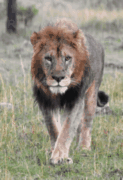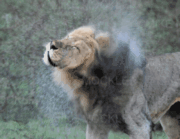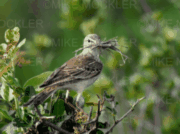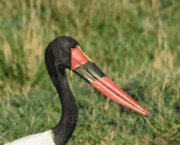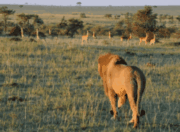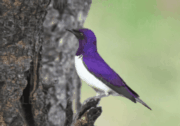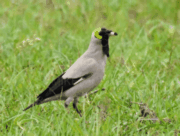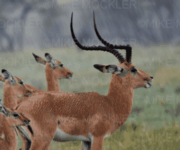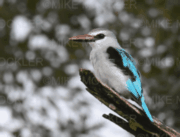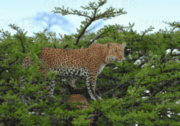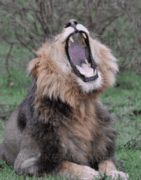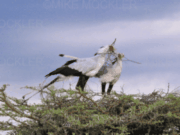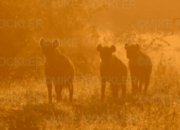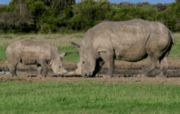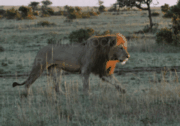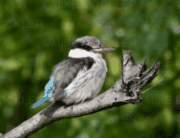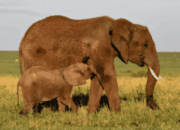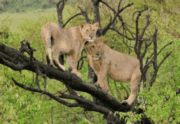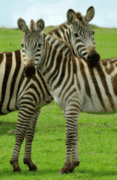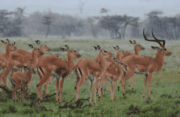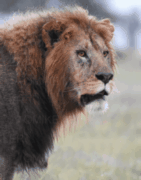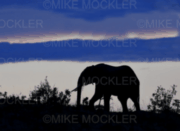|
Mike Mockler Kenya |
The start of the rainy season is the most dramatic and exciting time of the year in Africa. The parched, lifeless bush is transformed into a vibrant, green landscape: new swathes of grass and flowers appear as if by magic and new-born animals - impalas, gazelles, topis and warthogs - suddenly seem to be everywhere. Resident birds quickly acquire their colourful breeding plumage and begin singing and nest-building, while waves of migrant birds pour in from the north. After months of hazy, dust-laden skies, suddenly there is a dazzling clarity in the air. Dark storm-clouds build, providing magnificent backdrops for scenes bathed in golden sunlight. For photographers, this glorious light is a godsend and clouds, absent for so long through the dry season, provide that special breathtaking ingredient at sunset. Normally at this time, rain falls in dramatic downpours that are sometimes accompanied by ferocious displays of thunder and lightning. Africa doesn't do things by halves! Yet, within an hour or two, the sun comes out again and dripping vegetation steams. At least, that's what usually happens. Not in an "El Nino year", though! And 2015 was deemed to be just such a year. In parts of Kenya, the 2015 rainy season introduced itself with storms and deluges on a biblical scale and prodigious quantities of rain were dumped on the land. Heavy rain showers became prolonged downpours and the already sodden ground could absorb no more. In nearly 40 visits to the Masai Mara over the last 30 years, I've experienced some truly monumental storms and downpours but I've never seen the Mara so wet. Small streams had become surging torrents, safari camps were washed away and game-drives were frequently abandoned. Getting stuck in the notorious black cotton soil was a daily hazard and, on several game-drives, we had no choice but to batten down the hatches and sit out the storm. Although tourists and photographers may have been inconvenienced, wildlife faced a massive life-or-death challenge from these exceptional rain-storms. Young animals and migrating birds were especially affected. On one occasion we came upon a group of White Storks that had clearly had a torrid time on their epic flight from Europe. Grounded by storms, they were in a sorry state: bedraggled, saturated and completely exhausted. Some, apparently close to death, were lying flat on the ground, too weak to stand up without toppling over. Jackals were in attendance, patiently waiting for an inevitable meal. On a more positive note, the rains had created a bonanza for millions of insectivorous birds. At times the sky was full of flying termites that had been prompted to erupt from the ground by the torrential rain and the bush was alive with birds making the most of this enormous new supply of food. Prominent among them were some species of starling. At this point, it is necessary to explain that there are many species of starling in Africa and most of them are striking, even dazzling, in appearance (see the photograph of the gorgeous Golden-breasted Starling in the February 2014 Kenya report). One particularly glamorous species is the Violet-backed Starling. The male is spectacular with glossy purple upperparts that contrast vividly with a white belly. His demure female could be mistaken for a completely different species, resembling as she does a small Song Thrush. This species is sometimes difficult to find and can be unobtrusive but in this very wet year they were unusually abundant. Their close relatives, Wattled Starlings, were also much in evidence searching for insects in the lush grass around the feet of grazing animals. This species is attracted to herbivores and often hitches a ride on antelopes and gazelles in the manner of oxpeckers. Perhaps the particularly luxuriant conditions had provided extra energy as some of the males had developed unusually large black wattles under their chins. Other birds seen included striking species like Crowned Crane and Saddle-billed Stork, as well as many migrating raptors, among them Steppe Eagle, Lesser Spotted Eagle, Wahlberg's Eagle, Montagu's Harrier, Pallid Harrier, European Marsh Harrier and Hobby. Insectivorous migrants were able to gorge themselves on the cornucopia of insects - Lesser Kestrels, Eurasian Rollers, Eurasian Bee-eaters and many more. Kingfisher species that feed on insects rather than fish were also common: Woodland Kingfisher, Grey-headed Kingfisher, Striped Kingfisher and Pygmy Kingfisher. In the most ferocious rains-storms, herds of animals stoically huddled together with their backs towards the wind, waiting for the storm to pass. Lions always look disconsolate in the rain: plodding through plains ankle-deep in water, these big cats look pitiful. Males appear to suffer discomfort when their shaggy manes become saturated but this provides photographic opportunities when they shake rain-water from their manes. Many of the lion prides we encountered had cubs, which invariably provided hours of charming and amusing entertainment. One group of adventurous cubs were hilarious, clambering around clumsily in a dead tree, repeatedly falling when branches gave way beneath them. One unexpected highlight was a lengthy daytime encounter with a typically shy Aardwolf. This mainly insectivorous relative of the hyenas is rarely seen as it is largely nocturnal. Perhaps the super-abundance of insect food had tempted it out during daylight hours. We also enjoyed an uncommon sighting of a pair of Klipspringers, delicate little antelopes that live in the rockiest of places. The Mara Elephants were treated to large quantities of fresh green grass, which they evidently enjoyed after a long dry season when their diet was largely confined to leaves and branches. They were relaxed and contented as they fed around our vehicle at very close range. Spotted cats are usually readily located in the Mara conservancies and this year was no exception. We spent many enjoyable hours watching a mother Leopard with her two delightful, playful cubs. On one occasion we arrived to find the mother had killed a large male Impala, a difficult and dangerous prey for a female Leopard to tackle. She had stashed it high in an acacia tree, not in a fork or on a branch as is usually the case but right on the top of the canopy where it was clearly visible to soaring vultures. We also spent time with a very relaxed mother Cheetah and her small cub and watched the mother make an unsuccessful chase after some Impalas. All the above events were witnessed within Mara Conservancies which regularly provide game-viewing at least as good as in the Masai Mara Game Reserve itself. In fact, often it's much better. The added advantage of the conservancies is that there are far fewer vehicles and accommodation is in delightful, small camps. ************* North of the Equator, in the shadow of Mount Kenya, are some major private game conservancies, some of which include strongly protected areas for populations of both White and Black Rhinoceros. The two most important are Lewa Wildlife Conservancy (250 sq. kms) and the even bigger Ol Pejeta Wildlife Conservancy which encompasses an impressive 360 sq.kms. Both are globally important rhino sanctuaries and Ol Pejeta is home to the largest population of Black Rhinos in East Africa. These conservancies are heavily protected with electrified fencing, armed ranger patrols, watch-towers and security camera installations. There are gaps in the fencing (known as "corridors") which allow all wildlife to come and go freely - with the exception of the rhinos that are unable to get through the cleverly-designed corridors. With the value of rhino horn far higher than that of gold, these conservancies are doing a remarkable job in protecting these crucially important rhino populations. It is worth reminding ourselves that in South Africa rhinos are being poached at the appalling rate of almost 3 a day. The relatively close proximity to human habitation means that for some people these private sanctuaries can feel "less wild" than other wildlife areas. Yet these private sanctuaries are larger than some national parks and national reserves. Ol Pejeta is almost twice the size of Nakuru National Park with its own rhino sanctuary (188 sq kms), considerably bigger than the famed Samburu and Buffalo Springs National Reserves combined (296 sq kms) and almost as large as the iconic Amboseli National Park (392 sq. kms). Furthermore, Ol Pejeta has the highest density of wildlife of any Kenyan wildlife area outside the Masai Mara! So it was not surprising that we enjoyed excellent game-viewing there. A fine male Cheetah we first encountered three years ago provided one of many highlights. After a slow and patient stalk, the Cheetah took off at high speed in pursuit of a female Impala. As they raced past our vehicle, we could hear the pounding hooves and paws of hunted and hunter. The Impala escaped by the narrowest of margins. We also spent time with two lionesses lying hidden among bushes close to a water-hole where lines of Zebras were coming to drink. Their ambush seemed perfectly set up so we waited for some time to see what would develop. Eventually, however, it became apparent that nothing was likely to happen for some time so we moved on. Lions and Spotted Hyenas are increasingly abundant at Ol Pejeta, which almost certainly explains why Cheetah numbers are declining and the local Wild Dog pack, sadly, hasn't been seen for some time. The Alpha male and female were reported to have died and the remaining members of the pack apparently moved out of the area. Another highlight involved a Black Rhino mother and her small calf that were being followed by a impressive large male with splendid long horns. The bull was approaching the female when he became aware of something else a short distance away. In fact, this was our vehicle but with his poor eyesight he took us for a rival male. Black Rhinos are very endearing animals but their intelligence is as limited as their vision. The male Rhino decided to charge his audacious new rival, until, at close range, he realised our vehicle was rather larger than a Black Rhino, when he stopped abruptly! He then veered off and ran back to the female and calf before lumbering away with the two of them. On another occasion, a Black Rhino and a bull buffalo vied with each other for possession of a small mud-wallow. As each seemed equally fearful of the other, an amusing pantomime developed. Near the end of our stay, we came across some breeding herds of Elephants, one of which was accompanied by two colossal bulls. One herd came very close to our vehicle as they grazed peacefully. A young bull examined the top of our vehicle by sniffing it with his trunk, while a mature female gently placed her trunk across our windscreen. A friendly farewell gesture perhaps?
|
|
